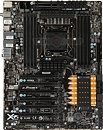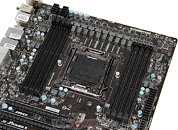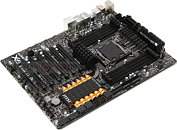Monday, November 7th 2011

MSI Big Bang XPower II X79 Monstrosity Smiles For The Camera
MSI is among the most secretive companies with their socket LGA2011 motherboard early information as the big Sandy Bridge-E day approaches (mid-November), yet we managed to score some early pictures of their top-end product from our spy-satellites and a network of cold war era retirees. Enter the MSI Big Bang XPower II, the company's top-tier socket LGA2011 motherboard for enthusiasts. This board is designed in the XL-ATX form-factor, and will fit in cases with at least 10 expansion slot bays. Thanks to the added board area, it's able to accommodate both a strong VRM, and high room for expansion (with eight DDR3 memory slots and seven PCI-Express slots).
To begin with, the LGA2011 socket is powered by a 24-phase VRM that makes use of driver-MOSFETs, solid-chokes, and High-C POSCAP capacitors. The memory is powered by a 4-phase VRM. The board draws power, apart from the 24-pin ATX, from two 8-pin EPS connectors, and an optional 6-pin PCIe (to stabilize PCIe slot power delivery). We can see many accessories to this VRM, such as phase-loading LEDs, and consolidated voltage measurement points. We are particularly intrigued by the design of the heatsinks over the VRM and chipset. The one over the VRM looks like the barrels of a Gatling gun, while the one over the chipset looks like a small piece from an ammo belt. You will either love it or detest it.Moving on to expansion, although the LGA2011 processor gives out 32 PCI-Express 3.0 lanes for graphics, the board is facing a lane budget deficit to wire its seven PCI-Experss x16 slots. Perhaps there is a PCI-Express bridge chip to give out additional lanes. The lane configuration is not known.
With storage connectivity, this board will give you a total of six SATA 6 Gb/s ports, from which two come from the X79 PCH, and four from additional controllers. Apart from the two 6 Gb/s ports, the X79 chipset also gives out four SATA 3 Gb/s ports. There are no eSATA ports. The board has a total of eight USB 3.0 ports, all driven by Renesas-made controllers, out of which four are on the rear panel, and four by internal headers. A nice touch here is that the front-panel headers are angled and laid beside the SATA port clusters.
The board features a high SNR (signal-noise-ratio) HD audio CODEC (probably ALC889), backed by Creative's X-Fi MB2 software that gives it even higher fidelity and more features. X-Fi MB2 software works on top of the HDA CODEC's native drivers, and so there is zero scope for any audio driver-related problems. The CODEC is wired to 8+2 channel analog outputs, optical and coaxial SPDIF outputs. There are two gigabit Ethernet connections, and surprisingly, both are driven by Intel-made gigabit Ethernet controllers. One of the two is driven by a compact 8257x series chip wired to the chipset's GbE lane, while the other is a full-fledged PCIe GbE controller. Both are backed by Intel's solid ProNetwork software and low-overhead drivers. Firewire and USB 2.0 make for the rest of the connectivity.The MSI BigBang XPower II will be backed by a feature-rich UEFI firmware. Expect it to be among the most premium LGA2011 boards.
To begin with, the LGA2011 socket is powered by a 24-phase VRM that makes use of driver-MOSFETs, solid-chokes, and High-C POSCAP capacitors. The memory is powered by a 4-phase VRM. The board draws power, apart from the 24-pin ATX, from two 8-pin EPS connectors, and an optional 6-pin PCIe (to stabilize PCIe slot power delivery). We can see many accessories to this VRM, such as phase-loading LEDs, and consolidated voltage measurement points. We are particularly intrigued by the design of the heatsinks over the VRM and chipset. The one over the VRM looks like the barrels of a Gatling gun, while the one over the chipset looks like a small piece from an ammo belt. You will either love it or detest it.Moving on to expansion, although the LGA2011 processor gives out 32 PCI-Express 3.0 lanes for graphics, the board is facing a lane budget deficit to wire its seven PCI-Experss x16 slots. Perhaps there is a PCI-Express bridge chip to give out additional lanes. The lane configuration is not known.
With storage connectivity, this board will give you a total of six SATA 6 Gb/s ports, from which two come from the X79 PCH, and four from additional controllers. Apart from the two 6 Gb/s ports, the X79 chipset also gives out four SATA 3 Gb/s ports. There are no eSATA ports. The board has a total of eight USB 3.0 ports, all driven by Renesas-made controllers, out of which four are on the rear panel, and four by internal headers. A nice touch here is that the front-panel headers are angled and laid beside the SATA port clusters.
The board features a high SNR (signal-noise-ratio) HD audio CODEC (probably ALC889), backed by Creative's X-Fi MB2 software that gives it even higher fidelity and more features. X-Fi MB2 software works on top of the HDA CODEC's native drivers, and so there is zero scope for any audio driver-related problems. The CODEC is wired to 8+2 channel analog outputs, optical and coaxial SPDIF outputs. There are two gigabit Ethernet connections, and surprisingly, both are driven by Intel-made gigabit Ethernet controllers. One of the two is driven by a compact 8257x series chip wired to the chipset's GbE lane, while the other is a full-fledged PCIe GbE controller. Both are backed by Intel's solid ProNetwork software and low-overhead drivers. Firewire and USB 2.0 make for the rest of the connectivity.The MSI BigBang XPower II will be backed by a feature-rich UEFI firmware. Expect it to be among the most premium LGA2011 boards.




70 Comments on MSI Big Bang XPower II X79 Monstrosity Smiles For The Camera
If I wanted some crayons I'd ask my nephew :laugh:
EDIT: Water cooling blocks FTW!
If there gonna stick nothin but pci-e's on a mobo, Why not make the board longer to be able to utilize them instead of half. Its a waste of space and plastic. I doubt your gonna stick 6-7 single slot 580's on a board. If I got a extreme board like this, I'd rather have a pci1 at the top of the pci-e instead of it gettin buried on almost all boards. And yea I know a pci1 will go on a pci-e lol.
seriously, Gigabyte must have err on their design department
EDIT
Damn, I just noticed the power for the CPU. How much juice does the Sandy Bridge E need?
yep, much better than that :toast:
GO buy a PS3 & glue some LED's to it if you're so vapid.
BUT - As far as sooo many ram slots and SOOO many Sata Sockets goes? *Drool* I think I'm in love...